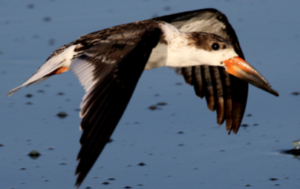- Appearance: black back and head, white underside, wings are black on top and white underneath, red legs, red beak with black tip, top half of beak is longer than bottom half
- no difference in plumage coloration, but males are noticeable larger than females
- Black skimmers used to be known as “scissor bills” because their beaks open very wide
- Length: 16-20 inches (about 1.5 feet)
- Wingspan: 14-15 inches (about 1.25 feet)
- Status: high concern, species has been declining since 1960’s
- Habitat
- Open beaches protected from waves, gravel or shell banks, mats of sea wrack (debris washed in from tides) in salt marshes, occasionally seen near large lakes
- Flooding and development of coastal beaches for human use is main reason for decline – black skimmers lose their nesting habitat under the slightest disturbance
- In southeastern US, sediment from dredging are used to build artificial islands on which they can nest
- Found year-round from North Carolina to Gulf Coast and California to Mexico
- Black skimmers are only found in North America
- It is the largest of three skimmer species, and the only one found in the Americas
- One other species lives in South Asia, another in Africa
 Diet
Diet
- Feed on small fish such as herring, killifish, needlefish, and small crustaceans
- Flies low (within a foot) over open water with bill open, lower bill trails through the water, cannot see prey, bill reflexively snaps shut when it touches a swimming fish
- Hunt at night when small fish are more likely to swim at water’s surface, but also hunt during the day, most active at dawn and dusk
- Only bird in the world whose pupils close vertically like a cat’s to keep out sunlight reflecting off water’s surface and bright-colored sand
- Black skimmers may travel up to 5 miles away from nesting site to find food
- Migration
- Long Island is the upper limit of the breeding range for black skimmers, which extends from Connecticut to North Carolina
- Arrive late April – early May, leave October – November
- One small colony settles farther north in Massachusetts
- Overwinter in coastal Mexico, small populations in Florida and California overwinter slightly inland
- Average flight speed is about 20 mph, maintains speed even when foraging
- Long Island is the upper limit of the breeding range for black skimmers, which extends from Connecticut to North Carolina
- Nesting
- Roost with colonies of skimmers, gulls, and terns
- Skimmers are highly social and form large colonies in winter as well
- When choosing a nest site, black skimmers fling sand as they begin to dig so that other members of the colony know that is their territory
- Aggressively defend nest from other birds, but use distraction displays for potential predators and humans – may escalate to diving if person stays
- Return to same nest site unless there is a disturbance – highly sensitive to human presence
- Mates take turns building nest, first a depression is scraped, then they sit in depression and rotate inside it to create saucer-shape nest (similar scrapes used year-round to rest)
- Average brood is 4-5 white or green eggs with brown or black speckles
- Black skimmers usually are last species of colony to lay eggs to benefit from colony defense when more aggressive birds such as terns are defending their eggs
- Roost with colonies of skimmers, gulls, and terns
- “Young of the Year”


 Upper and lower bill are equal length upon hatching
Upper and lower bill are equal length upon hatching
- As a black skimmer grows, the lower beak grows faster than the upper beak, constantly grows and is wore down by sand, mud, and rocks
- Sometimes the lower beak breaks if it hits a hard obstacle
- As a black skimmer grows, the lower beak grows faster than the upper beak, constantly grows and is wore down by sand, mud, and rocks
-
- Chicks can leave nest within a few days after hatching
- If approached by a predator, juveniles lie down on ground to “play dead,” they also dig a depression and cover themselves with sand for camouflage
- Parents will usually fly around to distract predator while young escape
- Black skimmers also rest lying flat on the ground with necks extended
- Fledglings learn to fly at about 3-4 weeks, but are still fed by parents, as their first hunts are met with mixed success
- Juveniles have brown backs with black wingtips and dark tails, when immature their backs, tails, and head darken on top but their necks whiten, then as adults their necks darken to black
- Live at least 20 years in the wild, oldest captured was at least 23 years old







